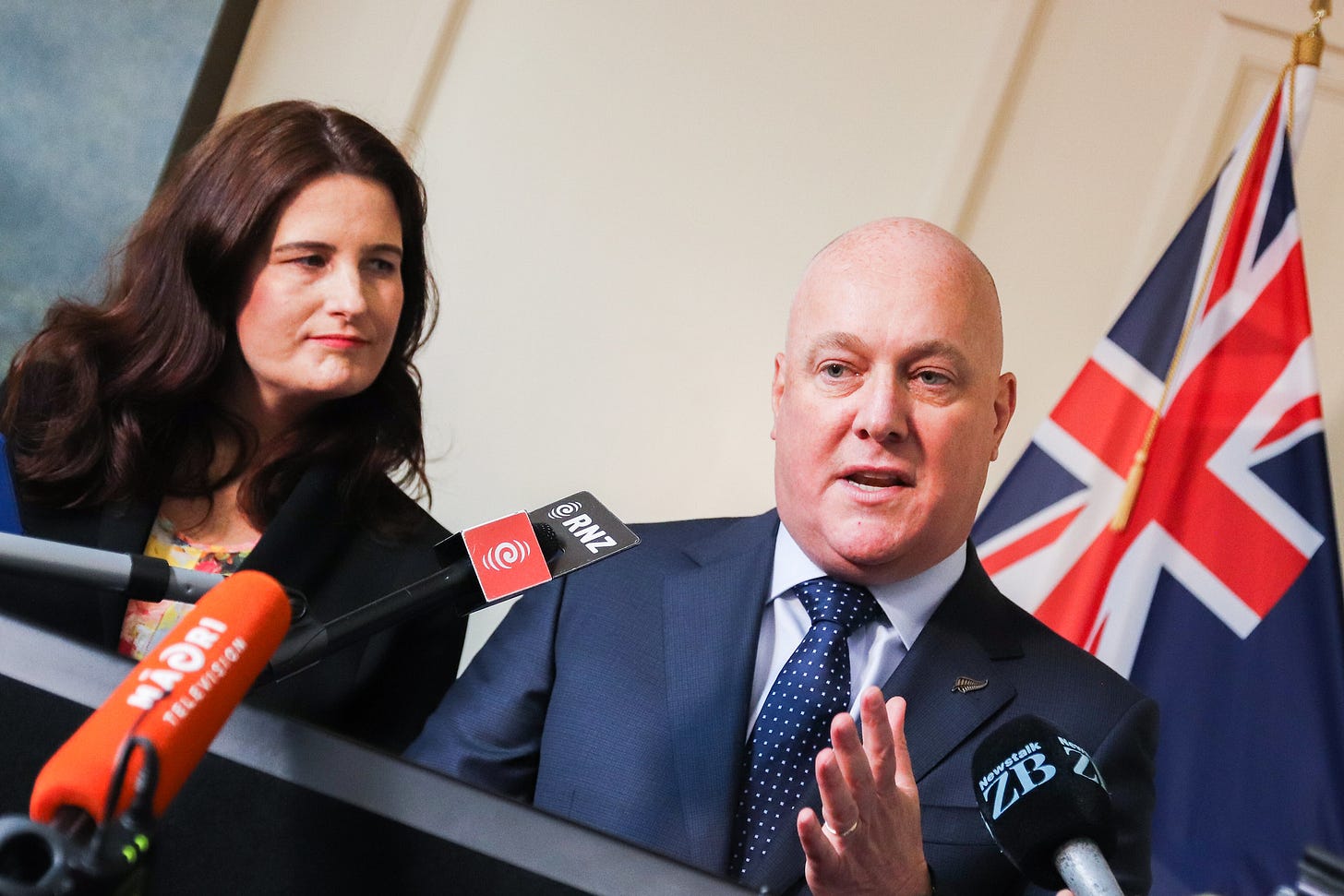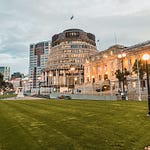
TL;DR: National Leader Christopher Luxon looks set to abandon within weeks the bipartisan ‘Townhouse Nation’ policy agreed and championed by his deputy Nicola Willis and his housing spokesman Chris Bishop.
He has caved to the NIMBYs in his party who are campaigning to stop houses being built anywhere near them for all the migrants they (paradoxically) want employed to provide the services they need to keep living in those houses. These NIMBYs essentially want new New Zealanders to drive much longer to work than they already do, and are relaxed or unaware about the brutally high housing costs and emissions liabilities this will impose on first home buyers and renters alike.
It either hasn’t occurred to them or hasn’t been explained to NIMBYs that they are sentencing themselves to watching their grand-kids grow up in Australia on WhatsApp, and are deciding to pass on crippling climate emissions liabilities to any of their offspring still left in this country. (See a lot more analysis and detail below the paywall fold).
Elsewhere in the news in Aotearoa’s political economy today
The RBNZ surprisingly dovish rate hike drove wholesale interest rates down about 35 basis points yesterday and could lead to mortgage rate cuts before the election;
The RBNZ saw the Government’s spending and taxation tracks as helping, rather than hindering, its inflation fight, which contrasted with the Opposition’s accusation that Budget 2023 would lead to higher mortgage rates;
There are 723 kids and over 1,500 people overall who are living in motels in Christchurch with an average stay of over six months, Sinead Gill reported for The Press-$$$ this morning;
The European Central Bank published a research paper that estimated that the climate change expected by 2035 would cause global increases in annual food and headline inflation of 0.92-3.23 and 0.32-1.18 percentage-points per year respectively; and,
Talks between Democratic US President Joe Biden and Republican speaker of the House of Representatives Kevin McCarthy about raising the US debt limit stalled overnight, increasing the risk the US Government would run out of cash as early as next Thursday and default on its debt — an event feared as catastrophic for global financial markets and banking systems that rely on US Treasury bonds as liquid and safe investments underpinning their balance sheets.
Usually, I put in a paywall for paying subscribers at this point in the email newsletter and lock off the podcast above from free subscribers. But I want to experiment until the end of June with publishing everything to everyone immediately to see what happens with subscription rates and email opening rates. I want to thank paying subscribers in advance, who are still the only ones able to comment and get access to our exclusive chat section and webinars. Join our community by subscribing in full to support my journalism in the public interest about housing unaffordability, climate change action and poverty reduction.
Luxon kills the hopes of the young to win the votes of the old
National Leader Christopher Luxon told voters in Birkenhead yesterday that the Medium Density Residential Standards (MDRS) that Willis shaped with Labour Housing Minister Megan Woods in 2021 were a mistake. The MDRS essentially allows the building of three three-story townhouses on a regular suburban section without a resource consent. Luxon said he preferred greenfields housing development.
Here’s what he was reported as saying by Simon Wilson in the NZ Herald today:
He revealed the change of heart during question time at a public meeting in the North Shore suburb of Birkenhead today, where he said: “I think we’ve got the MDRS wrong.”
Questioned later by the Herald, he said he was “ruthlessly obsessed” with building more houses, but would prefer to see a much greater focus on greenfields developments. Simon Wilson in the NZ Herald
This has been building for a while
Owners of stand-alone homes in the leafier inner-city suburbs in particular have been up in arms ever since MDRS was passed, saying they want lots of houses built and lots of new migrants, but just not next to them. When everyone says that in existing suburbs, the only choice is the outer fringes of the greenfields, and all the extra motorways and pipes and sub-stations water treatment plants that implies. Councils and the Government won’t pay for that infrastructure because that would force them to have higher taxes, rates and debt, all of which the old leafies also oppose.
Hence the housing shortages that have given Aotearoa the most expensive houses in the world to own and rent relative to incomes, along with the most stressed renters who can barely afford the rent, let alone food. Nearly 500,000 New Zealanders now need $4 billion a year in accommodation supplements and rent subsidies from the Government and are forced to use food banks to get enough to eat.
The surprising and welcome cessation of political hostilities that led to the bipartisan MDRS in mid 2021 had appeared to be a serious attempt to break the logjam in our political economy that looks like this:
the Government wants to run surpluses and keep public debt below 20-30% of GDP, which means it skimps on infrastructure investment and encourages population growth to bolster GST and PAYE receipts;
the Government does this to ensure interest rates generally and mortgage rates in particular are kept lower than would otherwise be the case;
those low interest rates support residential land values being at much higher levels than previously and much higher relative to incomes than in other countries;
those low mortgage rates protect the unearned, untaxed and leveraged capital gains median voters need to keep expanding so they can help their own kids get on the ladder;
Councils aren’t allowed to run deficits or borrow enough to pay their half share for new infrastructure because of rules set by Treasury in Wellington that allow Councils to borrow through the Local Government Funding Agency with a Crown guarantee;
those borrowing rules are designed to protect New Zealand’s AA+ sovereign credit rating, which helps keep interest rates low etc, etc;
these skimpy approaches to Crown and Council infrastructure spending mean they both try to pass the marginal cost of new infrastructure needed to cope with population growth onto the buyers of new homes, through development contributions and capital charges from electricity and telecommunications network providers; and/or
Councils and the Crown are structurally inclined to reject applications for greenfields and brownfields developments because of the cost of new infrastructure, even after the imposition of the DCs and capital charges, which don’t cover all the costs;
Residents and incumbent businesses wanting to protect their views, noise-levels, profits and on-street car parks can use the Resource Management Act to block and delay developments; and,
the politics of all of these intertwined blockages to housing development reward the owners of residential-zoned land and the owners of land on the fringes of cities, who can benefit from value increases from rezonings and don’t have to worry about competition from a densification of housing closer to city centres.
It’s a gnarly problem at the heart of our political economy
The ability to make tax-free and leveraged capital gains is at the heart of this gordian knot restricting housing supply. It is reinforced by population growth that is engineered without either debate about the infrastructure necessary to support it in any sustainable way, or permission from council and general election voters.
One potential solution is a supply shock of extra land or houses that drag down house prices overall and land prices in the outer suburbs, which would destroy the expectations of fast and un-ending rises in land prices that drive the land-bankers’ business models and the investment appetites of owner occupiers.
That’s why ‘Townhouse Nation’ was so important. It threatened to unpick the gordian knot, albeit without the funding needed to fund much of the infrastructure needed for brownfields development. The basic problem of Luxon’s greenfields preference is that it has to include commitments from Governments and Councils to fund the developments because it won’t happen at any significant scale at the moment. Development contributions are not nearly enough.
Luxon, Willis and Bishop have to yet to say how such development would be funded by Government or others. But the usual playbook from both National and Labour is to talk about capital being introduced from private sources through Public Private Partnerships (PPPs), whereby Governments, Councils and investment funds or private land owners contribute both debt and equity for projects. But these have proven problematic, complicated, slow and expensive at any large scale both here and overseas.
PPPs are largely discredited, even with market-oriented conservative Governments in Australia and Britain. In New Zealand, PPPs can best be written off by referring to the experiences of the two major PPPs done in recent years: Transmission Gully and the new Mt Eden Prison. Serco was dumped six years into a 10-year $300 million contract managing Mt Eden and Transmission Gully was delivered three years late with a crumbling surface and hundreds of millions over budget.
So what happens now?
We’ll see just how dead MDRS would become under a National Government, although it’s now almost irrelevant whether or not National wins the election because the opponents of MDRS at council level and the potential developers and off-the-plan buyers will know to run a mile if their plans depend on MDRS.
Other views with more detail
writes well about the political aspects of Luxon’s comments in this piece out overnight.Here’s Malcolm McCracken’s
Substack with a piece on the issues.Ka kite ano
Bernard

















Luxon kills the hopes of Townhouse Nation